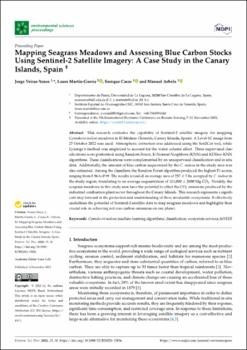Mapping Seagrass Meadows and Assessing Blue Carbon Stocks Using Sentinel-2 Satellite Imagery: A Case Study in the Canary Islands, Spain
Date
2023Abstract
This research evaluates the capability of Sentinel-2 satellite imagery for mapping
Cymodocea nodosa meadows in El Médano (Tenerife, Canary Islands, Spain). A Level-1C image from
27 October 2022 was used. Atmospheric correction was addressed using the Sen2Cor tool, while
Lyzenga’s method was employed to account for the water column effect. Three supervised classifications were performed using Random Forest, K-Nearest Neighbors (KNN) and KDTree-KNN
algorithms. These classifications were complemented by an unsupervised classification and in situ
data. Additionally, the amount of blue carbon sequestered by the C. nodosa in the study area was
also estimated. Among the classifiers, the Random Forest algorithm produced the highest F1 scores,
ranging from 0.96 to 0.99. The results revealed an average area of 237 ± 5 ha occupied by C. nodosa in
the study region, translating to an average sequestration of 111,000 ± 2000 Mg CO2
. Notably, the
seagrass meadows in this study area have the potential to offset the CO2 emissions produced by the
industrial combustion plant sector throughout the Canary Islands. This research represents a significant step forward in the protection and understanding of these invaluable ecosystems. It effectively
underlines the potential of Sentinel-2 satellite data to map seagrass meadows and highlights their
crucial role in achieving net zero carbon emissions on our planet.






